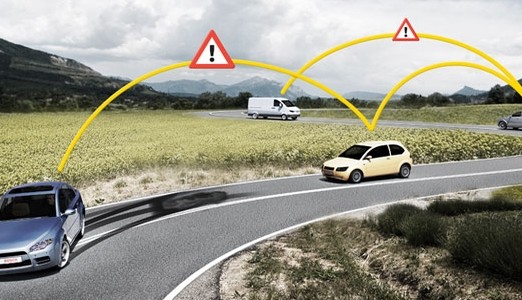Intelligent cars alert each other to hazards
on

The largest field test for vehicle-to-vehicle and vehicle-to-infrastructure communication (car-to-X communication) worldwide is about to get under way. Scientists, auto makers and communication companies as well as public-sector institutions have teamed up to develop a system that allows cars to share information on traffic conditions and impending hazards. The aim is to promote a safer, more efficient flow of traffic. Researchers from the Technische Universität München (TUM) are currently involved in devising the test scenarios that 120 vehicles will use to put the system dubbed simTD through its paces on
Notice traffic blocks before they are visible. Recognize risky situations before they get out of hand. Reach your destination on time, safe and relaxed. The “Safe and
The simTD–System is using wireless technology that was specifically developed for this automotive field of application. The technology is based on the well-known WLAN standard. Information can either be transferred directly to other vehicles or to Roadside Stations installed along the road. If the communication partner is not located in close vicinity to the sender, other vehicles can transmit or store and forward information.
The vehicles transmit information on the traffic conditions to the control station, which can then predict and manage traffic developments. A display provides drivers with recommendations on the best route. The system also assists drivers at intersections or traffic lights by providing a timely display of the right lane for the next turn, or the optimum speed to ride a “wave of green traffic lights.”
The system also alerts drivers to imminent hazards. An emergency braking lamp in the display, for instance, warns the driver if a vehicle ahead brakes heavily – well before the driver is physically able to react to the situation. Where rescue services are responding to an incident, the system shows the direction and the lane taken by the emergency vehicles, enabling the driver to know precisely where they are. If obstacles, such as lost cargo, are blocking the road, drivers receive timely advice on alternative routes.
What kind of formations, at what times, and which routes do the individual vehicles in the test fleet have to take to produce reliable results? Scientists from the TU München are looking at all these questions. Their remit is to prepare the field test and subsequently to analyze the huge amounts of data produced. Together with the
The Federal Ministry of Economics and Technology (BMWi), the Federal Ministry of Education and Research (BMBF) and the Federal Ministry of Transport, Building and Urban Development (BMVBS) provide funding for simTD, because this consortium has the potential to promote a new dimension of foresighted driving, traffic control, and accident avoidance. The ministries are convinced that a commonly agreed standard is essential for the commercial deployment of this pace-setting technology.
simTD is a joint project initiated by leading German automakers, automotive suppliers, communication companies and research institutes, together with assistance from the public sector. Project partners are as follows: Adam Opel AG, AUDI AG, BMW AG, BMW Forschung und Technik GmbH, Daimler AG, Ford Forschungszentrum Aachen GmbH, Volkswagen AG,
Source:



Discussion (0 comments)